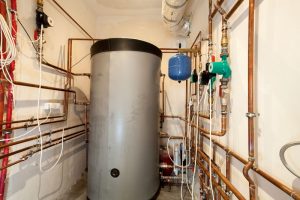 It’s one thing for your water heater to stop working one day (unless you like washing your dishes with cold water). But it’s another thing entirely for your water heater to leak or even burst.
It’s one thing for your water heater to stop working one day (unless you like washing your dishes with cold water). But it’s another thing entirely for your water heater to leak or even burst.
Unfortunately, with water heaters, a leak isn’t something you can just patch up—it means the end of your water heater. Likewise, a water heater burst is just as dangerous as it sounds. Before that can happen, we’ll tell you what to look out for.
Sediments in the Tank
One of the most harmless and common water heater problems can become the cause of a leak if not properly taken care of. The water that comes into your water heater will naturally have some level of minerals in it, which will become sediment at the bottom of your heater, and this can cause problems.
For one, it will take longer to heat the water, which can lead to too much pressure inside the tank, and that can cause it to burst (more on that later).
Second, all that sediment can trap heat underneath itself, and this can create hot spots. These hot spots will continue to get hotter and hotter until the tank springs a leak.
Sediment buildup needs to be flushed a couple times a year. If you can’t remember the last time you had the sediment flushed out of your water heater, now might be a good time to take advantage of a Boston plumber’s emergency plumbing hours.
The Anode Rod is Corroded
Water heater tanks are corrosion magnets. Even with a glass layer lining the inside of the water tank, the corrosion can still break through this layer and get to the tank—and that means a leak. This has brought about the need for the anode rod.
The anode rod is sometimes called the “sacrificial anode rod” based on its sole function: to protect the water heater tank. The rod is made of a metal that attracts corrosive elements to it, and it can take quite a beating—it’s recommended that you have to replace the anode rod only once every five years. That’s nearly half of the water heater’s entire lifespan!
Too Much Pressure
We’ve saved the worst for last. Even though all it takes is a simple leak to ruin your water heater, that doesn’t mean your water heater can’t also dramatically burst and cause damage or bodily harm.
The only way that too much pressure can build in the tank is if the temperature gets too hot. Anything about 140 degrees is going to increase the pressure in the tank. If you set the temperature to 120 to 125 degrees instead, there should be no problems.
In the event that this happens, the temperature relief valve will open up to help alleviate the pressure. That means you’ll want to test this valve every now and then to make sure it’s working properly. If this valve breaks, or if the water heater’s temperature climbs higher without your input, then it would be best to call in for emergency services before the problem can get out of hand.

